On the Hunt for Philippe Auguste’s Wall in Paris


- SUBSCRIBE
- ALREADY SUBSCRIBED?
BECOME A BONJOUR PARIS MEMBER
Gain full access to our collection of over 5,000 articles and bring the City of Light into your life. Just 60 USD per year.
Find out why you should become a member here.
Sign in
Fill in your credentials below.
Paris is like a layer cake where 2000 years of history sit on top of one another. Much of this history is destroyed but fragments remain and reward those who search for them. Some of the most tantalizing traces are found in what remains of the city’s fortifications.
Right up to the middle of the 19th century, Paris was always confined by one city wall or another. Even now, Paris within the Boulevard Périphérique is referred to as “intra muros” (inside the walls). But only the Philippe Auguste Wall has left visible remains.
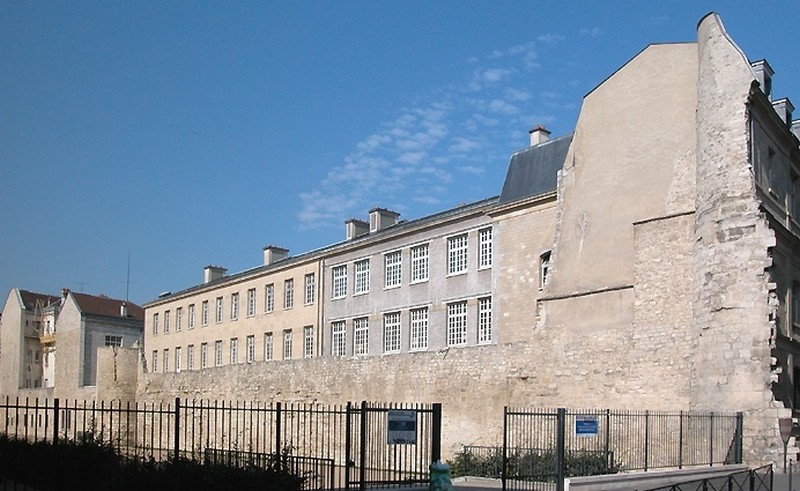
The longest existing part of the Philippe Auguste Wall is located at the corner of rue Charlemagne and the rue des Jardins-Saint Paul. Photo credit: Sam Spade/ Wikimedia commons
France suffered many kings who were venal, incompetent or simply mad. Philippe Auguste was one of its more capable monarchs. In 1190 he departed France on the Third Crusade but had the foresight to strengthen Paris’s defenses during his absence. Between 1190 and around 1215, a wall was built encircling Paris, starting at the Louvre, continuing through the lower Marais, across the modern-day Île Saint Louis and through the Latin Quarter, before ending at the river again where the Institut de France now stands.

Traces of the wall of Philip II Augustus. Credit: Open Street Map/ Wikimedia commons
A measure of his success is that vestiges of these defenses remain over 800 years later. Let us take a walk around the eastern section, from the Marais to the Latin Quarter. Along the way we will see not just physical remains, but also hidden clues that make seeking the wall a fascinating detective story. Strolling through narrow streets with centuries-old houses, we can imagine all the noise, smells and dirt that filled the labyrinthine alleys of the city in medieval times.
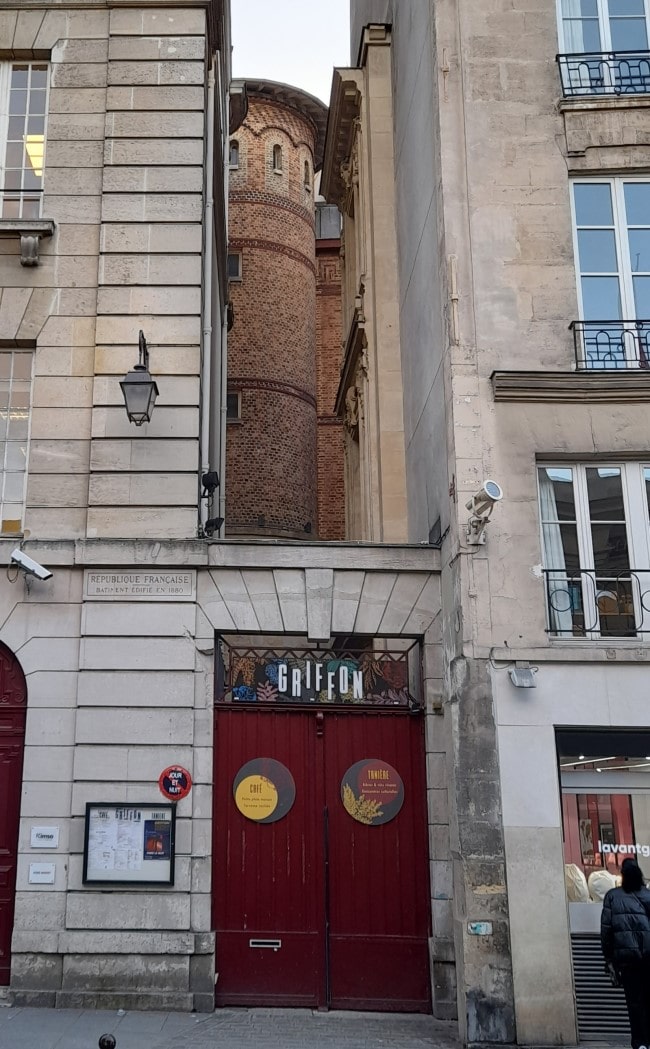
The Tour Pierre Alvart, part of the historic wall, on the rue des Francs Bourgeois in the Marais. © Pat Hallam
We start in the Rue des Francs-Bourgeois, in the heart of the Marais. At number 57-59, tucked away down a passage behind the Crédit Municipal, we see an extraordinary polychrome brick tower. Yes, the base of this, inside the courtyard, is an original tower from the wall. The wall stood 8-10m high, about 3m thick at the base tapering to 2m, topped with a rampart. A dozen gates with drawbridges and portcullises provided entrances to the city. Every 60-70m stood a tower, including this one, the Tour Pierre Alvart.
We follow the course of the wall down the Rue des Francs-Bourgeois to the Rue des Hospitalières-Saint-Gervais. A gap between the side of number 12 and the primary school next door and a fragment of masonry belies the wall’s original position.
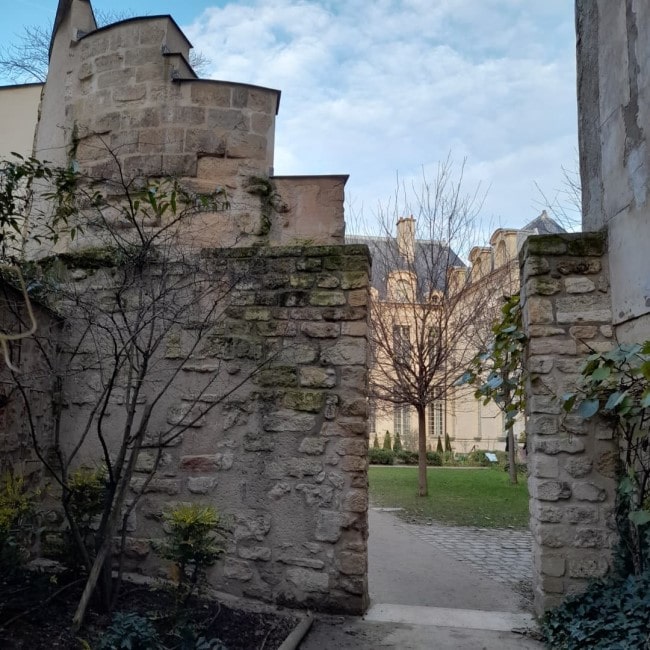
The tower’s wall and gateway visible in the Jardin Joseph-Migneret in the Marais. © Pat Hallam
The end of this street joins Rue des Rosiers, the center of Paris’s Jewish quarter known as Le Pletzl. Although filled with boutiques today, a few Jewish bakeries, falafel restaurants, and bookshops remain and an active synagogue is just a few minutes away. Halfway down the street we come to the Jardin Joseph-Migneret where a poignant memorial to deported children reminds us again of the area’s Jewish history. But what really draws the eye is part of a tower and a gateway from the wall that now form the entrance to the garden. Originally the private garden of the Hôtel d’Albret, it was neglected until it was rescued between 2007-2014. It is now a tranquil spot to bring your falafel sandwich at lunchtime.
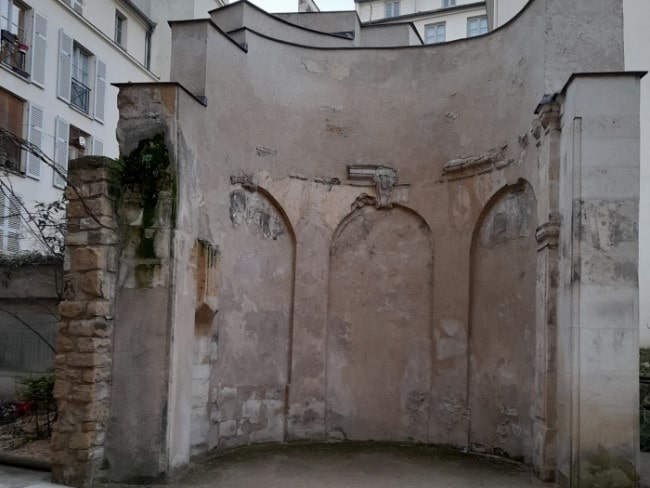
Interior of the tower in the Jardin Joseph-Migneret. © Pat Hallam
We continue down the Rue Pavée to the busy Rue Saint Antoine and cross the road to take the Rue Prevôt directly in front. Turning left into Rue Charlemagne, we walk towards the lycée. Even before we reach the school we can see a tall chunk of masonry jutting on to the pavement.
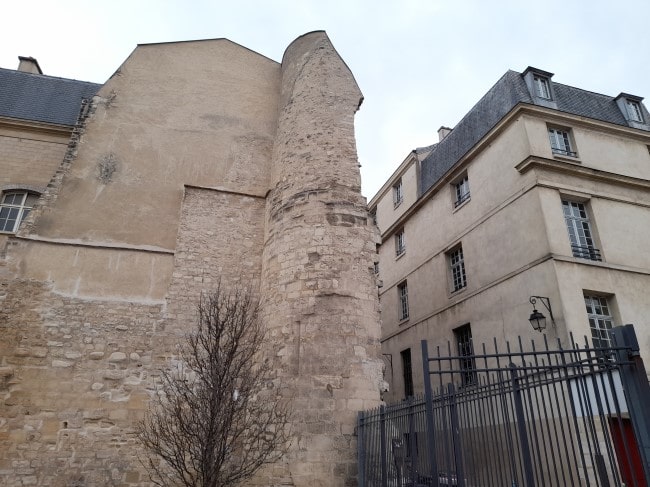
The Tour Montgomery, part of the wall, visible on Rue Charlemagne. © Pat Hallam
This is one of the jewels of medieval Paris: the longest existing stretch of the Philippe Auguste Wall, and you get a real sense of how imposing it once was. The Tour Montgomery abutting the pavement is still almost full height, and the curtain wall is about two-thirds its original height. Even better, the remains of a second tower still stand 60m from the Tour Montgomery. Imagine this encircling the medieval city and you see a virtually impregnable fortification.
The wall is fronted by a popular basketball court and the other side has been integrated into the gym of the lycée. History is seamlessly integrated into Parisians’ daily life.
From here, the Rue des Jardins Saint Paul runs down to the Seine, where we turn right and follow the river to Pont Marie. On the way, like a scene from Rapunzel, we see the conical turrets of the Hôtel de Sens, dating from the late 1400s (although much restored) and the oldest ex-private mansion left in Paris. It now houses an important fine arts library.

The Hôtel de Sens. Photo credit © Camlamb (CC BY 2.0)
The Pont Marie crosses the river to Île Saint Louis. The course of the wall was obviously interrupted here so heavy chains were strung across the Seine both up and downstream to open and close river access to the city. The elegant, 17th-century townhouses that typify the island were built when two islands, Île Notre Dame and Île aux Vaches, were joined into one. An aristocratic suburb sprang up which has kept its social cachet. On the far side the Pont de la Tournelle drops us on to the Left Bank at the easternmost end of Boulevard Saint-Germain.

7bis Blvd St Germain. © Pat Hallam
Let’s walk down the boulevard just a few meters, to number 7bis, and you notice something bizarre. Number 7bis is very narrow, just the doorway’s width in fact. Why? Well, because it’s possibly infill where the wall once stood. Look across the road and the building opposite is single storied with open space above, but the buildings behind are at an angle. That is a dead giveaway that the Philippe Auguste Wall ran through there. Similar angled gaps can be seen in several places, especially on the Left Bank. Once you recognize them, they are a sure sign the course of the wall is nearby.
The wall on this side of the river was doubly fortified by a ditch. Even without visible remains, you can trace its course through street names like Rue des Fossés Saint Bernard (fossé means ditch or moat). Another telltale sign is an old street name including the word contrescarpe. This was the outward-facing side of an embankment.
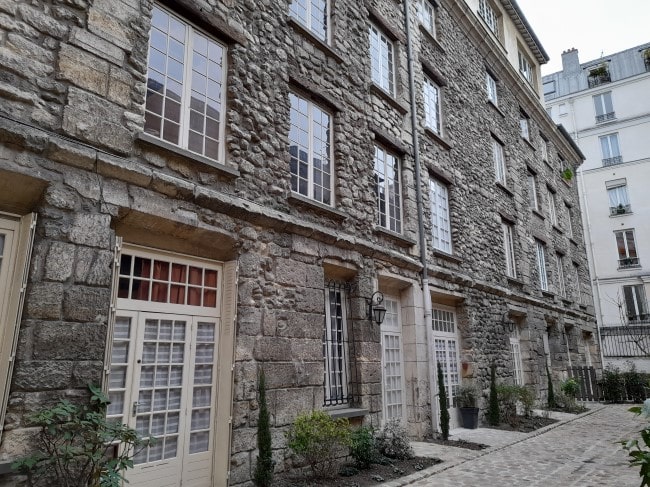
Reusing stones from the wall at 28bis Rue Cardinal Lemoine. © Pat Hallam
Frustratingly, many physical remnants of the wall are hidden in courtyards or basements and cellars, or have been reused. But if you are patient you may see someone leaving a courtyard and can walk in. So, if we walk up Rue Cardinal Lemoine to number 28bis, next door to the Paradis Latin club, and are lucky to get into the courtyard, we will see how stones from the wall have been recycled to build the houses. Further up at number 48-50 another sizeable section is integrated in a wall of the fire station. One side is open to the air; the other forms one wall of an internal corridor. Next door is the Bibliothèque des Littératures Policières, Europe’s biggest library of crime and espionage books.
A few meters further up the hill, a turning on the right brings us face to face with our final major section of wall, near the bottom of Rue Clovis. A fine cross-section clearly shows its construction: an internal and an external wall of dressed stone filled with a core of rubble set in cement that makes up most of the width. This section, like the one at Saint Paul, is pretty much full height and stretches away from the street into back gardens. Further up Rue Clovis, at number 7, the courtyard at the back reveals the full section of wall, including the rampart. If you are lucky and catch someone coming out, you might be able to sneak in for a quick look.
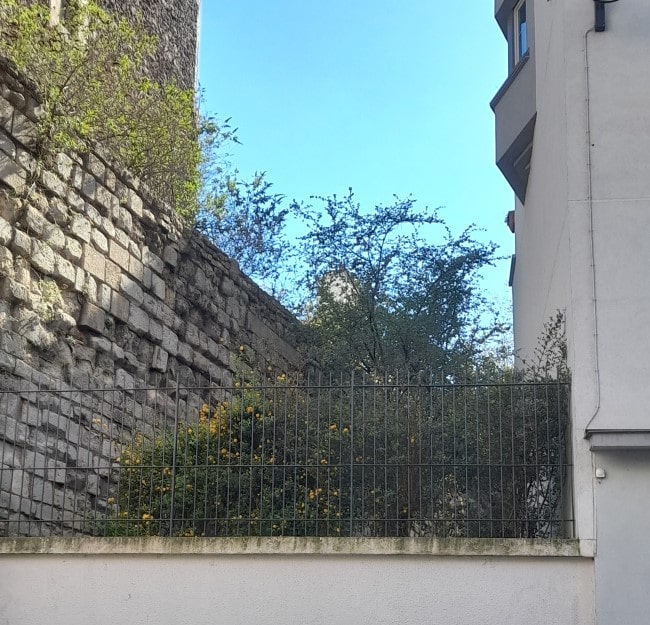
Behind 1 Rue Clovis. © Pat Hallam
This brings us to the end of this walking tour but the wall continues through the Latin Quarter and other fragments are visible on both sides of the Seine; below is a rundown of the best:
Left Bank
Rue Dauphine – the optician Hervé Domar at number 48 and jeweler Isabelle Toledano at number 40 both have stretches of the wall inside their shops. In the jeweler’s there is part of a tower as well.
Rue Dauphine – opposite the corner of Rue André Mazet you can clearly see another of these angled gaps between buildings, where the wall once stood. The wall in the jeweler’s shop continues the line.
Rue Mazarine – the underground car park has beautiful remains of a tower and the wall on two levels – if you can get in and out (the car park is private).
Impasse de Nevers – the cul-de-sac end of Rue de Nevers has a fragment of wall at pavement level.
Quai de Conti – a plaque marks the site of the Tour de Nesle, one of four extra-fortified towers controlling access in and out of the city.
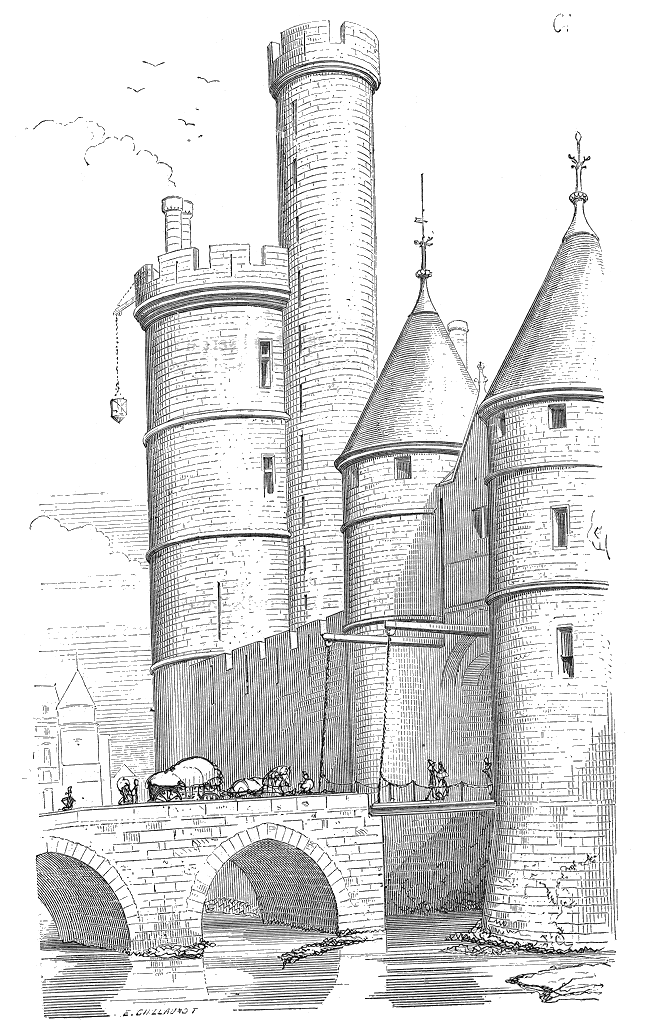
Representation of the Tour de Nesle by Eugène Viollet-le-Duc, 1856.
Right Bank
The Louvre – the lowest level of the Louvre contains the excavated remains of Philippe Auguste’s original fortress, which marked the beginning of the wall.
Rue du Louvre – at number 13 you can see the interior of a tower like an architectural cutaway.
Tour Jean Sans Peur- Rue Étienne Marcel. This 15th-century tower is interesting in its own right, but opposite the reception desk is part of a Philippe Auguste tower that extends to the lower ground floor.
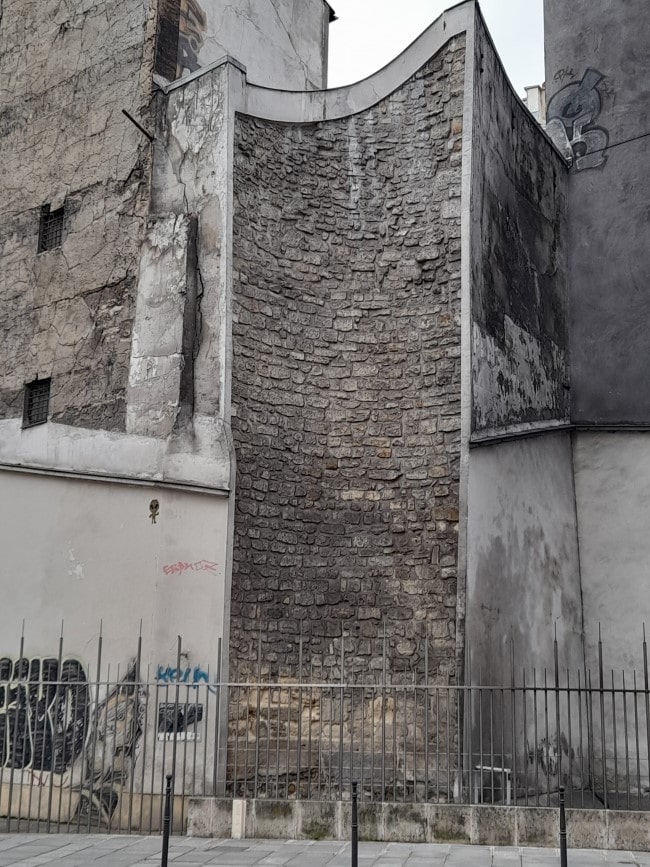
Interior of a tower, vestige of the wall, on Rue du Louvre. © Pat Hallam
Lead photo credit : Map of Sebastian Münster (1572). In blue, the walls of Philip Augustus, and on the Right Bank by the wall of Charles V. Public domain.
More in history, middle ages, Paris Walks



REPLY